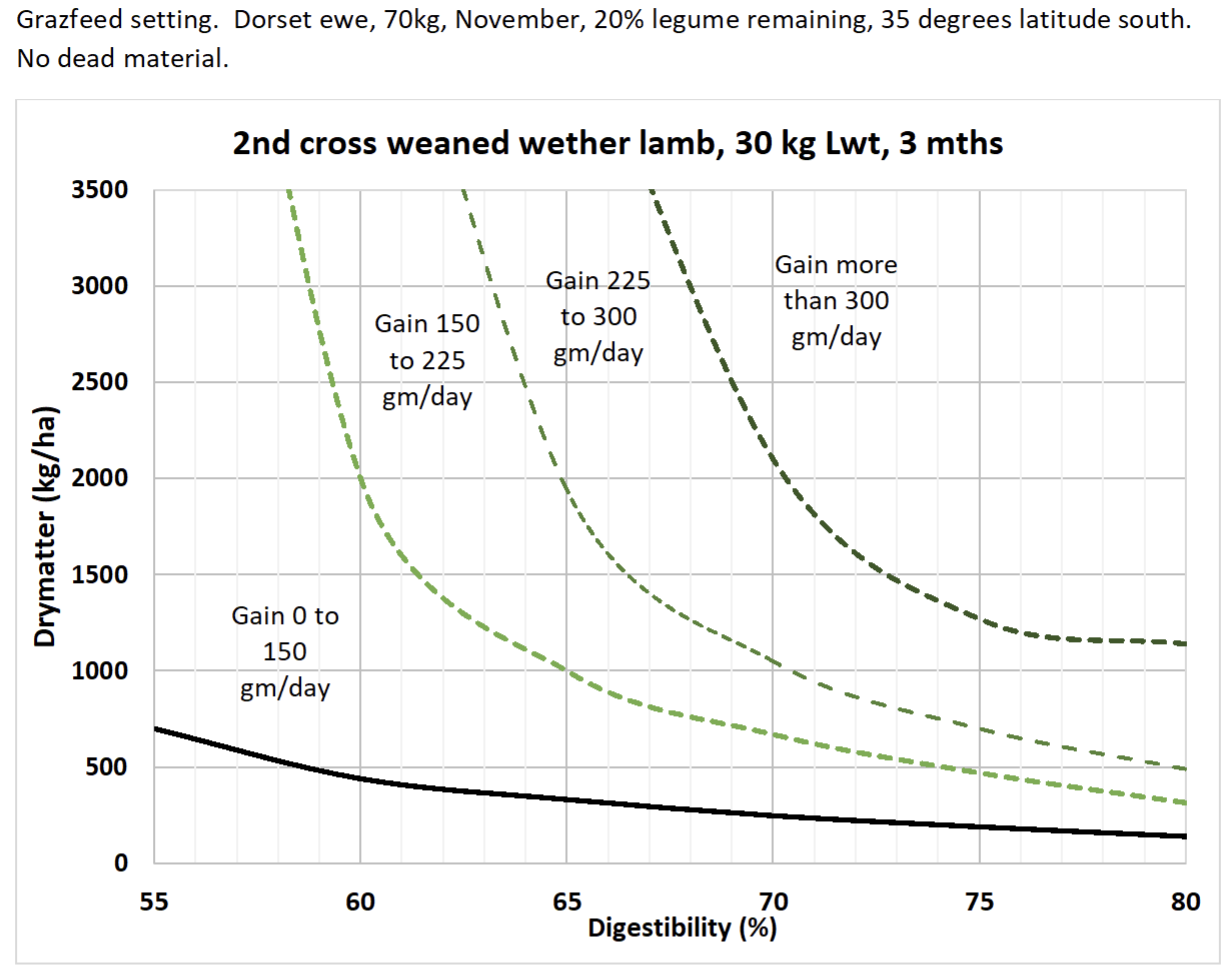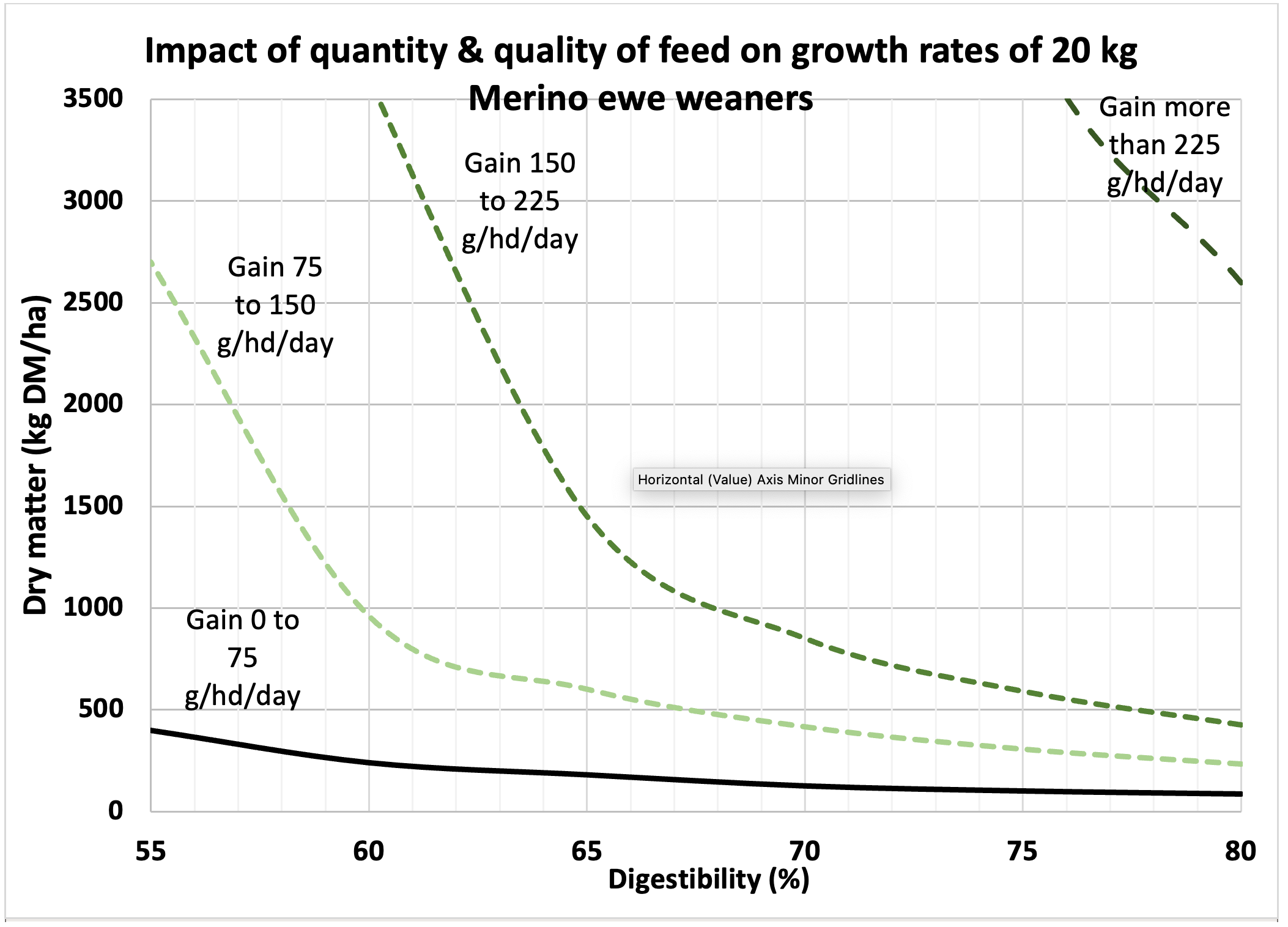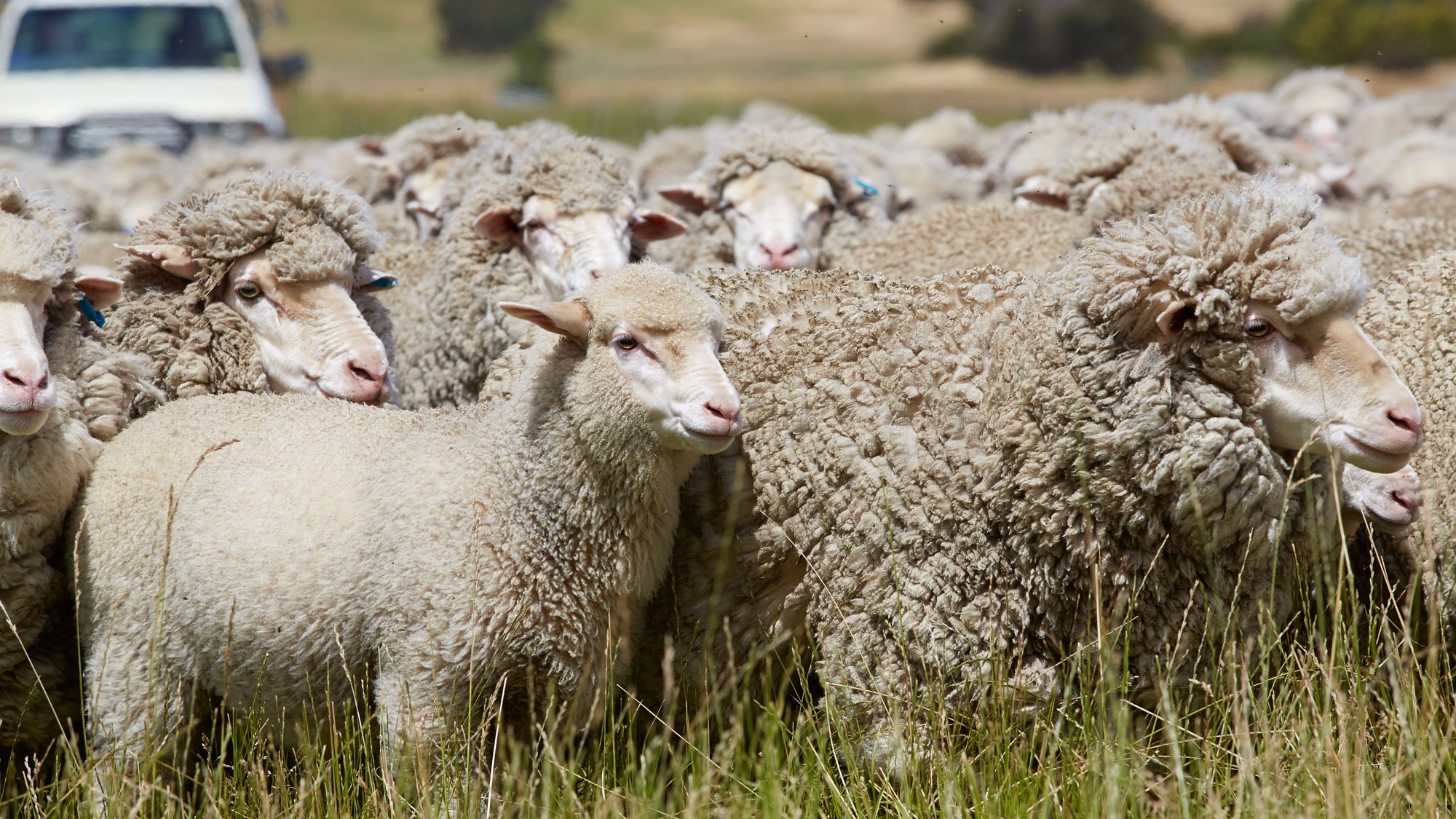Chapter 10.4 Manage weaners for lifetime productivity
Background information
Management of lambs after weaning has an important influence on reducing post weaning mortality, lifetime productivity and profitability. There are three key management aspects affecting weaner productivity:
- Merino weaners need to reach bodyweight targets to ensure highest survival rates.
- All ewe weaners need to reach growth targets after weaning to achieve satisfactory reproduction performance as maiden ewes.
- Meat breed weaners require access to quality feed to achieve growth targets and meet market specifications.
Excessive post weaning mortality rates are a major financial and animal welfare concern and significantly affect enterprise productivity and profitability.
At a glance
- Wean lambs no later than 14 weeks after the start of lambing.
- Wean lambs onto high-quality, low worm pasture to ensure continued growth rate and post-weaning growth and survival.
- Better manage feeding programs by weighing or assessing a random sample of weaners every 4–6 weeks post-weaning.
Introduction
There is a strong association between post weaning survival bodyweight and growth rate. Some features of this relationship include:
- Small increases in weaning weight make a profound difference to weaner survival. For example, a 14 kg weaner has a 34% lower mortality risk than a 12 kg weaner, whereas a 20 kg weaner has a 22% lower mortality risk than an 18 kg weaner.
- Small increases in the monthly growth rates for weaners can dramatically reduce mortality rates, e.g. an increase of 0.25-0.5kg/month can reduce the mortality risk by 74%.
- Faster growing and heavier weaners accumulate more body reserves that they can use if required.
- The close association between growth rate, bodyweight and mortality risk means that supplementary feeding is often a cost-effective option in weaners.
- Special attention to weaner health is required, such as vaccination, drenching and flystrike prevention. Refer to MMFS Module 11 Healthy and Contented Sheep.
Ewe weaners must have sufficient growth rates to reach the liveweight targets set in chapter 10.1 to ensure adequate conception at first joining, regardless of their age.
Set growth targets for your weaners depending on their purpose. For example, lambs which are being raised for meat will need to grow more quickly and at a higher growth rate to meet market specifications for slaughter than replacement ewe lambs who will be joined as hogget maidens. Give priority access to best, high-quality pasture to meat lambs after weaning (see chapter 8.3 in MMFS Module 8 Turn Pasture into Product) so that market specifications can be met (see chapter 3.1 in MMFS Module 3 Market Focused Lamb and Sheepmeat Production) but continue to ensure that all weaners are growing and meeting growth targets.
Preparation of weaning paddocks
Early selection of paddocks is a critical component of managing lambs immediately after weaning. Features of ideal weaning paddocks include:
- High feed quality: gold standard is mixed species, actively growing green feed at 1,800-2,100 kg DM/ha FOO. Feed tests should be completed to understand the megajoules of metabolisable energy (MJ ME) and crude protein (CP%) in the feed to ensure it meets the minimum requirements for your weaners.
- Low grass seed infestation: particularly barley grass or corkscrew. If lambs need to graze risky paddocks either spray top or slash grass seed heads to reduce the hazard (see Winning Against Seeds in signposts section).
- Low worm risk: specially prepared paddocks with low worm burdens (see chapter 11.2 in MMFS Module 11 Healthy and Contented Sheep).
- Good quality stock water: easy access to clean, cool drinking water and multiple watering points in larger paddocks. Imprinting lambs onto different water sources (e.g., trough types, dams, etc.) prior to weaning will help. Many lambs will be reluctant to drink from a trough type that is different to what they have experienced previously or if there is dust on the top of the water in their trough. This can be a problem particularly immediately after weaning in hot conditions.
Animal performance is largely driven by the type of animal (breed, age, size, sex, physiological condition) and the quality and quantity of feed they consume. It is possible to get the same level of animal performance out of different combinations of quality and quantity of feed. Figure 10.4 and 10.5 below shows achievable growth rates based on the quantity (vertical axis) and quality (horizontal axis) of feed on offer (FOO).
In figure 10.4, the solid black line represents maintenance for a weaned, 30 kg second cross lamb, and the dotted lines represent growth at 150 g/hd/day, 225 g/hd/day and 300 g/hd/day. For example, if you wanted those lambs to gain 225 g/hd/day, you could offer 750 kg/DM/ha of 75% digestible feed or 1,900 kg/DM/ha of 65% digestible feed, or any other combination of quantity and quality on that line.

Figure 10.4 Growth rates expected for a 3-month-old, 30 kg, weaned second cross wether lamb out of a 70 kg Dorset ewe, depending on the quantity (kg DM/ha) and quality (digestibility) of feed on offer (FOO). Modelled on pasture in November at 35 degrees latitude south with 20% legume remaining, no dead material.
Source: Cam Nicholson, Nicon Rural Services, analysed from GrazFeed data, adapted by AWI and MLA.
Similarly, in the Merino example shown in figure 10.5, the dotted lines represent growth rates of 75 g/hd/day, 150 g/hd/day and 225 g/hd/day, so if you want the lambs to grow at 150 g/hd/day, you could offer 600 kg/DM/ha of 75% digestible feed of 1,450 kg/DM/ha of 65% digestible feed.
The Merino modelling was run for December (as compared with the second cross example which was run for November), so an allocation has been factored in for an amount of dead material in the paddock which has an estimated digestibility of 45%. All of the calculations in figure 10.5 are for the green FOO only, with the assumption that each scenario has the 500 kg of dead material added on top.

Figure 10.5 Growth rates expected for a 4-month-old, 20 kg, weaned Merino ewe lamb out of a 55 kg Merino ewe, depending on the quantity (kg DM/ha) and quality (digestibility) of feed on offer (FOO). Modelled on pasture in December at 35 degrees latitude south with 20% legume remaining, 500 kg/ha dead material at 45% digestibility.
It is not recommended to maintain light weaners, and growth targets should be a minimum of 50 g/hd/day.

Age at weaning
Wean lambs no later than 14 weeks after the start of the lambing. At three months, milk provides only 10% of total feed requirements and weaning onto high-quality pasture with a low risk of worms will ensure continued growth and low post-weaning mortality.
Weaning lambs at an earlier age has production benefits, such as:
- Heavier liveweight that can be more easily maintained for turnoff or until first joining.
- Better ewe condition due to increased recovery period.
- Higher conception rates for ewes at next joining.
- More lambs weaned from the following year’s lambing.
- Weaned lambs grow more wool.
- Breeding ewes grow more wool.
These benefits are greatest in poor and variable seasonal conditions.
Weigh and draft lambs into weight groups at weaning
Aim to have weaners reach target weaning weight of 45% of their standard reference weight (SRW – see tool 10.7) at weaning. To achieve this target, weigh or assess a representative sample of lambs at weaning and, when practical, draft weaners into groups for preferential management. Weaners weighing less than 45% of SRW need to be managed to ensure weight gain of at least 1 kg per month to hit their target and keep growing.
Post weaning mortality is highest in the three months following weaning with the lightest weight and slowest growing weaners being most at risk (table 10.1). Management to increase weight gain in weaners that are below target weaning weight and to ensure weaners continue to grow after weaning will eliminate up to a third of deaths. Formulate supplementary feed rations to account for pasture quality and availability (see chapter 11.1 in MMFS Module 11 Healthy and Contented Sheep).
Table 10.1: High weaner survival rates are a function of weaning weight and positive post-weaning growth rates – both are important to increase the survival of weaners.
Source: AWI Winning With Weaners
| Group | Weaning weight (kg) | Post-weaning growth rate (g/ sheep/ day) |
Proportion of flock (%) | Mortality (%) |
| 1 | 23.9 | 62.9 | 36.5 | 0.8 |
| 2 | 18.1 | 135.8 | 10.5 | 0.0 |
| 3 | 22.0 | -9.7 | 14.1 | 11.2 |
| 4 | 17.1 | 65.9 | 38.9 | 7.6 |
Monitor weaner liveweight
Monitor or assess weaner liveweights regularly post-weaning to ensure your weaners keep growing at the targeted growth rate. It is also important to monitor pasture quality and quantity to feed budget and check the FOO is meeting the nutritional requirements of your weaners. Where necessary, redraft weaners into appropriate weight groups and provide the best available pasture (and supplementary feed where required) to the low weight group.
Growth targets for ewe lambs
Ewe lambs need to grow to achieve minimum liveweight targets set for maiden ewes from birth to pre-joining in tool 10.5. The target weight at any given time depends on the SRW (tool 10.7) of your ewe flock. As a guide, manage ewe hoggets to reach 80% of their SRW before they are joined.
When planning to join ewe lambs at 7-10 months of age, ensure they reach at least 45 kg at joining and are provided with quality feed to continue to grow after joining, through pregnancy to lambing. Preferentially allocate pasture to ewe weaners to ensure they meet growth targets. Formulate feed supplements depending on pasture quality and availability (see chapter 8.2 in MMFS Module 8 Turn Pasture into Product and signposts).
SIGNPOSTS
WATCH
The first season of AWI Change Makers is a ten-part video series centred around sheep reproduction. Tune in to hear leading livestock consultant, Nathan Scott, demonstrate a range of practical ways growers can influence sheep reproduction with the latest research and tools informed by the AWI-funded research and development outcomes.
- Episode 2 – Weaning to manage
READ
USE
A decision support software tool to help graziers improve the profitability of livestock production through more efficient use of pastures and supplementary feeds.
View feed budget tables based on feed on offer (FOO) for annual clover-based pastures and mixed perennial and annual pastures.
Calculate individual growth rates of lambs and predict finishing times.
Assists sheep producers to proactively manage the nutrition of their ewe flock through the reproduction cycle utilising condition scoring and feed on offer (FOO) assessments.
Assists sheep producers to proactively manage the nutrition of their ewe flock through the reproduction cycle utilising condition scoring and feed on offer (FOO) assessments.
ATTEND
The course is delivered in small groups of 5-7 sheep producers that meet six times per year with a professional trainer. During these hands-on sessions, the group visits each participating farm and learns skills in condition scoring, pasture assessment and best practice ewe and lamb management to increase reproduction efficiency and wool production, mainly through reducing ewe and lamb mortality.
A practical, one-day workshop highlighting the key production benefits of superior genetics, plus feed management for improved reproductive performance and livestock productivity.
Designed for woolgrowers and is aimed at improving weaner management of their Merino flock, targeting 95% weaner survival to one year of age. WWW identifies key practical actions and tools for commercial enterprises to implement on farm to achieve this performance aim.
Groups of 5-7 participants meet for five sessions within 12 months to implement weaner management strategies on farm, focusing on weaner management, containment feeding, joining ewe lambs and genetic selection.






